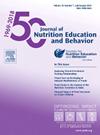Gaps in Nutrition Assistance Programs for International Students in Institutions of Higher Education in the United States
IF 2.3
3区 医学
Q2 EDUCATION, SCIENTIFIC DISCIPLINES
引用次数: 0
Abstract
Background
High rates of food insecurity of up to 57% have been reported in college students in the United States (US). International students account for 6% of the US collegiate population. Yet, there is still limited data on the full extent of food insecurity among international students, including their access to nutrition assistance programs.
Objective
This study examined policy gaps in federal nutrition assistance programs and explored the availability of community-level programs available for international students in the US.
Study Design, Settings, Participants
The protocol of this review was registered on PROSPERO (ID: 616263). The search strategy for this study was two-fold. First, the authors accessed each state’s Supplemental Nutrition Assistance Program (SNAP) and the United States Department of Agriculture websites to identify any policies relevant to international students. Second, following the PRISMA guidelines, the authors searched for peer-reviewed articles on PubMed, CINAHL Complete, PsycINFO, ScienceDirect, and ERIC databases that provided evidence on existing community programs or interventions for this target group. The search yielded 2,091 articles, with fourteen articles meeting the inclusion criteria.
Measurable Outcome/Analysis
Gaps in existing federal and community nutrition assistance programs for international students in the US.
Results
The prevalence of food insecurity among international students ranged from 26.8% to 61%. SNAP’s eligibility criteria excluded the majority of international students. International students were neither restricted nor specifically mentioned as eligible for the Women Infants Children program. Other gaps included limited research on food insecurity and interventions for international students, lack of funding to support procurement and distribution of healthy foods to this group, and lack of partnerships between campus food security initiatives, university services, and community programs to address the complex needs of international students.
Conclusions
Despite the existence of on-campus food pantries in US colleges and universities that help food-insecure international students, other solutions are needed. There is a critical need for federal and state agencies to revise their policies that expand access to nutrition assistance programs among international students.
Funding
None
美国高等教育机构国际学生营养援助计划的差距
据报道,美国大学生的粮食不安全率高达57%。国际学生占美国大学生总数的6%。然而,关于国际学生食品不安全的全面程度的数据仍然有限,包括他们获得营养援助计划的情况。目的:本研究考察了联邦营养援助计划的政策差距,并探讨了美国国际学生可获得的社区一级计划的可用性。研究设计,设置,参与者本综述的方案在PROSPERO (ID: 616263)上注册。这项研究的搜索策略是双重的。首先,作者访问了每个州的补充营养援助计划(SNAP)和美国农业部的网站,以确定与国际学生相关的任何政策。其次,遵循PRISMA指南,作者在PubMed、CINAHL Complete、PsycINFO、ScienceDirect和ERIC数据库中搜索同行评议的文章,这些文章提供了针对该目标群体的现有社区项目或干预措施的证据。检索结果为2091篇,其中14篇符合纳入标准。可衡量的结果/分析针对在美国际学生的现有联邦和社区营养援助计划存在差距。结果留学生食品不安全发生率为26.8% ~ 61%。SNAP的资格标准排除了大多数国际学生。国际学生既没有受到限制,也没有特别提到有资格参加妇女婴儿儿童计划。其他差距包括对国际学生食品不安全和干预措施的研究有限,缺乏资金支持向这一群体采购和分发健康食品,校园食品安全倡议、大学服务和社区计划之间缺乏合作伙伴关系,以解决国际学生的复杂需求。尽管美国高校存在校园食品储藏室,帮助食品不安全的国际学生,但还需要其他解决方案。联邦和州政府机构迫切需要修改其政策,扩大国际学生获得营养援助项目的机会。FundingNone
本文章由计算机程序翻译,如有差异,请以英文原文为准。
求助全文
约1分钟内获得全文
求助全文
来源期刊
CiteScore
4.20
自引率
11.50%
发文量
379
审稿时长
44 days
期刊介绍:
The Journal of Nutrition Education and Behavior (JNEB), the official journal of the Society for Nutrition Education and Behavior, is a refereed, scientific periodical that serves as a global resource for all professionals with an interest in nutrition education; nutrition and physical activity behavior theories and intervention outcomes; complementary and alternative medicine related to nutrition behaviors; food environment; food, nutrition, and physical activity communication strategies including technology; nutrition-related economics; food safety education; and scholarship of learning related to these areas.
The purpose of JNEB is to document and disseminate original research and emerging issues and practices relevant to these areas worldwide. The Journal of Nutrition Education and Behavior welcomes evidence-based manuscripts that provide new insights and useful findings related to nutrition education research, practice and policy. The content areas of JNEB reflect the diverse interests in nutrition and physical activity related to public health, nutritional sciences, education, behavioral economics, family and consumer sciences, and eHealth, including the interests of community-based nutrition-practitioners. As the Society''s official journal, JNEB also includes policy statements, issue perspectives, position papers, and member communications.

 求助内容:
求助内容: 应助结果提醒方式:
应助结果提醒方式:


